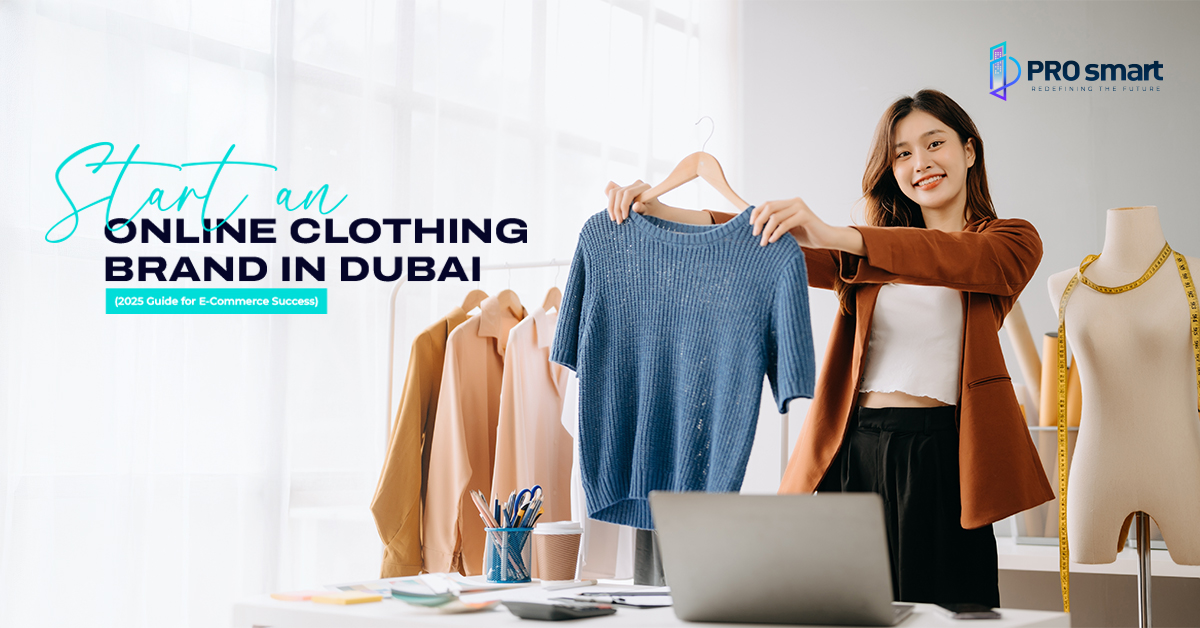Blog
Start an Online Clothing Brand in Dubai (2025 Guide for E-Commerce Success)
- November 24, 2025

Dubai isn’t just about malls anymore it’s one of the fastest-growing e-commerce markets in the region. The UAE’s online market is projected to cross AED 48.8 billion by 2028, with fashion being one of the top spending categories.
If you’ve been thinking about launching your own online clothing brand, Dubai is one of the best places in the world to do it. With the right license, niche, and marketing strategy, you can sell through your website, Instagram, marketplaces, or all three.
This guide walks you through why Dubai is ideal, how to set up legally, what it costs, and what actually works in the UAE fashion market.
Why Start an Online Clothing Business in Dubai?
1. Strong E-Commerce Growth
- UAE e-commerce hit around AED 27.5 billion in 2023 and is expected to almost double by 2028.
- Fashion and apparel are consistently among the top online categories in the UAE.
This means demand is already there – you’re not educating the market; you’re competing on brand, quality, and experience.
2. High Spending Power
Dubai residents have high disposable income and are used to shopping online for:
- Modest fashion
- Luxury brands
- Streetwear and athleisure
- Custom and made-to-order pieces
If your product is positioned well, people are willing to pay for quality and convenience.
3. 99% Internet Penetration
About 99% of UAE residents are online, and a huge chunk of purchases happen via mobile, social media, and apps.
That means:
- Instagram, TikTok, Snapchat, and Google Ads actually convert
- You can build a brand without a physical shop, just with a solid online presence
4. Government & Infrastructure Support
- Free zones like Dubai CommerCity, EZDubai, IFZA, and Meydan are built specifically for digital commerce.
- Logistics and last-mile delivery are strong, with partners like Aramex, Talabat, Noon, etc.
Dubai is basically engineered for e-commerce brands to scale quickly.
How to Start an Online Clothing Store in Dubai (Step by Step)
Setting up with a proper structure from day one saves you from issues with banks, payment gateways, and compliance later. Here’s a simplified roadmap:
1. Choose Your Fashion Niche
Instead of “selling everything,” pick a niche that matches market demand + your positioning.
| Niche | Example Products | Target Audience |
| Modest Wear | Abayas, hijabs, long dresses, kaftans | Local & regional customers |
| Luxury / Occasion Wear | Evening gowns, designer pieces, premium accessories | High-income expats, tourists |
| Streetwear | Oversized tees, cargos, sneakers, hoodies | Gen Z, young professionals |
| Sustainable / Conscious Fashion | Organic cotton, linen, recycled fabrics, pre-loved pieces | Eco-aware shoppers |
| Athleisure & Activewear | Gym sets, joggers, sports bras, modest sportswear | Fitness & wellness crowd |
| Kids & Family Matching Sets | Kidswear sets, “mini-me” outfits | Parents & families |
Before finalizing:
- Check what’s already working on Instagram, Noon, Amazon, Namshi, Trends
- Study what local influencers are promoting
- See if you can differentiate with design, quality, or story
2. Decide Your Business Model
Your business model impacts cost, risk, and margins.
| Model | Pros | Cons |
| Dropshipping | Low startup cost, no stock, easy to test many designs | Lower margins, quality & delivery depend on supplier |
| Reselling Existing Brands | Faster launch, known brands | Less differentiation, wholesale costs reduce margins |
| Private Label (Your Own Brand) | Full control over branding & quality, higher margins long-term | Higher upfront investment, more time & management |
| Multi-brand / Marketplace Style | Wider range, multiple suppliers or designers | More complex logistics & inventory, tougher ops |
For a long-term brand, private label or a strong reseller model usually wins. For testing the market, dropshipping can help you start lean.
3. Choose Trade Name & Legal Structure
You’ll need:
- 3 trade name options (usually in English; Arabic translation can be arranged)
- A legal structure, such as:
- LLC (Limited Liability Company)
- Sole Establishment
- Free Zone Company (FZ-LLC, FZE, FZCO depending on the zone)
- LLC (Limited Liability Company)
The ideal choice depends on:
- Whether you want to sell globally or mainly in the UAE
- If you need a physical office/warehouse or can work from a flexi-desk
- How many partners/shareholders you have
PRO Smart can help map this based on your budget & growth plan.
4. Get Your E-Commerce Trade License
You can set up your online clothing brand either in a free zone or on the mainland.
Free Zone (e.g., Meydan, IFZA, Dubai CommerCity, Dubai South):
- Lower setup cost
- 100% foreign ownership
- No need for a retail shop
- You can still sell across the UAE using local delivery partners
Mainland (DED / Dubai Economy):
- Good if you plan to also have a physical shop or studio
- Easier if you want to serve government entities or do certain B2B deals
Most new online clothing brands start in a free zone with an e-commerce or trading license and use:
- Shopify / WooCommerce
- Plus marketplaces like Amazon, Noon, or local platforms
Typical license approval time: about 1–4 weeks, depending on the free zone and documents.
5. Open a Corporate Bank Account
You’ll need a business bank account to:
- Receive online payments
- Pay suppliers and logistics
- Keep your finances separate and clean for accounting
Banks will usually ask for:
- Trade license
- Passport & visa of owners
- Simple business plan / profile
- 6-month bank statements (if you already trade elsewhere)
A proper e-commerce license and clear activity description make approvals smoother.
6. Build Your Online Store & Operations
You can choose one or a mix of these:
Store Platforms:
- Shopify – easiest for e-commerce beginners
- WooCommerce (WordPress) – more flexible, but more technical
- Marketplaces – Amazon, Noon, Namshi, etc.
Payment Gateways (UAE):
- Stripe
- Telr
- PayTabs
- Network International
Delivery & Logistics Partners:
- Aramex
- Jeebly
- DHL / FedEx
- Local last-mile partners
For your site, make sure you have:
- High-quality photos
- Clear size charts
- Return/refund policy
- Arabic + English options (if you’re targeting a wider base)
- Easy checkout and mobile-friendly design
How Much Does It Cost to Start an Online Clothing Brand in Dubai?
Your investment depends on your jurisdiction, model, and scale, but here’s a rough breakdown:
| Item | Approximate Range (AED) |
| Free zone e-commerce license | 5,000 – 12,000 (starting, varies by zone) |
| Mainland e-commerce license | 15,000 – 20,000+ |
| Basic website / Shopify setup | 3,000 – 8,000 (depending on design & dev) |
| Initial inventory (if stocking) | 10,000 – 50,000+ |
| Branding, photoshoots, packaging | 3,000 – 10,000 |
| Marketing & ads (launch phase) | 5,000 – 15,000+ |
| Payment gateway & platform fees | % per transaction + small monthly fees |
These are ballpark figures and can be optimised depending on:
- Whether you hold stock or drop ship
- How premium your product is
- Whether you start with a simple MVP store or full brand experience
PRO Smart can help you build a cost plan and avoid unnecessary spending in the first year.
4 Practical Tips to Make Your Clothing Brand Work in the UAE
- Offer Cash on Delivery (COD) at the start
Many customers still prefer COD when trying a new brand. You can always shift more towards card/payments later. - Leverage Reviews & UGC (User-Generated Content)
Encourage customers to post photos and reviews in exchange for small discounts or perks. Social proof is huge in fashion. - Double Down on Localised Marketing
- Use Arabic + English ads
- Focus on Dubai, Abu Dhabi, Sharjah with geo-targeted campaigns
- Collaborate with micro-influencers instead of only big names
- Think About Sustainability & Story
Consumers here respond well to:
- Eco-friendly fabrics
- Modest yet stylish options
- Clear brand story (who you are, why you started, what you stand for)
Start Your Online Clothing Brand With PRO Smart Business Services
Launching an online clothing brand in Dubai involves:
- Licensing
- Jurisdiction choice
- Legal structure
- Banking
- E-commerce setup
When you’re handling products, branding, and marketing, you don’t want to be stuck in paperwork.
PRO Smart Business Services can help you with:
- Choosing the right free zone or mainland setup
- Getting your e-commerce trade license
- Structuring ownership, visas, and activities correctly
- Coordinating with banks, payment gateways, and portals
Ready to launch your clothing brand?
Book a consultation with our team and get a clear roadmap, cost breakdown, and setup plan tailored to your idea.
Frequently Asked Questions (FAQs)
1. Do I need a license to sell clothes online in Dubai?
Yes. You must have a valid trade license (e-commerce or trading) to legally sell clothing online in the UAE, whether through your website, Instagram, or marketplaces.
2. Is a free zone or mainland better for an online clothing brand?
For most online-only brands, a free zone is more cost-effective and flexible.
If you also want a physical shop, showroom, or mall presence, a mainland license may be more suitable.
3. How long does it take to get an e-commerce license?
Typically, once all documents are ready, the license can be issued in about 1–4 weeks, depending on the free zone and approvals.
4. Can I start an online clothing brand in Dubai if I’m not a UAE resident?
Yes. Many free zones allow non-residents to set up companies. Once the company is formed, you can also apply for a UAE residence visa through your business.
5. Do I need to hold inventory, or can I dropship?
You can do either:
- Dropshipping – lower upfront cost, but less control over quality and delivery.
- Stock-based model – higher investment, but better control over brand, packaging, and customer experience.
6. Can I sell outside the UAE as well?
Yes. With an e-commerce license in Dubai, you can sell to international customers, as long as your logistics and payment gateways support those countries.
7. How much should I budget for marketing?
As a starting point, many new brands allocate at least AED 5,000–10,000 per month on:
- Meta (Instagram/Facebook) ads
- TikTok / Snapchat campaigns
- Influencer collaborations
Your exact budget depends on your goals and pricing.





